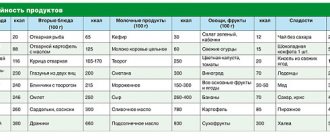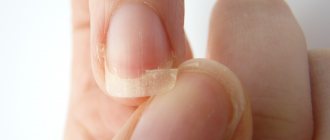To understand what a calorie deficit is and how you can use it to lose weight, let’s remember the basic course in dietetics. A person receives from food the energy he needs for life: organ function, movement and mental activity.
Sources of energy are proteins, fats and carbohydrates (BJC), which are found in various dishes and products. Absolutely everything contains calories, even alcohol.
The exception is special drinks with zero calories. The sweet taste is due to the sweetener.
Everything else we eat turns into energy, which we spend on various activities and life in general.
You're getting fat
Now imagine that calories are a salary. Every day you spend money on food, transportation, housing, utilities, etc. In reality, this is energy expenditure for walking, thinking, digesting food and much more.
So, if your salary exceeds your expenses, you accumulate financial resources - calories. Where should the accumulated funds go? That's right - they need to be put aside in reserve.
You can store excess unused energy in the human body by creating fat stores. This is how you gain weight.
We drive away excess weight
The truth, which is accepted as an axiom, is that to lose weight you need to spend more energy than you receive, that is, create a calorie deficit.
How to create it?
First, calculate how many kcal you need.
A little theory
To calculate, it is important to take into account not only the energy value of what you eat, but also where you need to spend your strength and energy during the day, respectively.
Why is this so important? In order not to disrupt the usual working rhythm, not to harm the body and maintain its vital functions at the proper level.
So, for the calculation it is necessary to take into account two important factors, namely that
During the day energy is consumed by:
Your Basal Metabolism
That is, it is spent on meeting your daily needs (sleep, brain function, maintaining body temperature, etc.). Basic metabolism depends on your gender, age and initial weight, and even height.
Your daily activities
This includes
- Household activities – everyday activities, except sports. Going to the store to buy bread, cooking dinner, queuing at the cash register, etc. and so on.
- Digestion of food - energy costs go to digesting soups, salads and hamburgers in your gastrointestinal tract.
- Training is running, exercise equipment, fitness and any other sports activity.
Considering the above list of needs, you can think about where you can “take away” energy from in order to get the coveted deficit.
However, I note:
Nuances of mathematics
- We are unlikely to be able to influence basic needs, and this is risky - the body takes as much as it needs, and trying to deprive it of this is dangerous to life and health.
- If we talk about sports, then it’s worth considering which type of activity burns more and which burns less.
Practice shows that during training, fat begins to burn only 40-45 minutes after the start. Fat is burned most quickly during cardio training or 3 hours after the last dose.
Paths to success
You can achieve what you want in two ways:
- Reduce the energy value of what you eat
- Add physical activity.
The most effective option for creating a calorie deficit is to use both methods, combining them wisely. Unfortunately, not everyone does this and not always - sometimes people simply cut down their diet greatly, trying to get rid of those annoying pounds as quickly as possible. I strongly advise against doing this - you risk getting stress, depression, and at the same time losing your hair, elastic skin, and, well, your health.
Consequently, the main priority becomes to establish nutrition - the success of the whole business will depend on it.
And here one difficulty arises - how to know how many calories to cut off from your diet? 100? 200? Maybe 500? To answer this question, let's calculate the daily caloric intake.
Losing weight
It's quite simple. Now imagine that you are not paid as much as you would like. There is not enough money for your daily expenses, so you have to spend your nest egg. In our case, its role is played by fat on the abdomen, waist, and hips. If you continue to receive less, you will begin to waste your nest egg, that is, accumulated fat.
When you eat fewer calories than you need to cover energy costs, the body creates a calorie deficit , and the body makes up for the lack of energy from its fat reserves. This is how you lose weight.
Weight standards
Perhaps it’s worth starting with the most important thing, namely, determining weight standards, determining the level of body fat and the very concept of calorie deficit in dietetics.
There are classic formulas that determine weight standards for men and women:
- Height – 110 for men,
- Height – 120 for women.
For athletes, slightly different formulas for calculating weight are used, which take into account increasing mass. In particular these are:
- Height – 100 for men,
- Height – 110 for women.
How correct is it to follow this formula? Let's be honest - it is far from perfect and is only a statistical factor among athletes who are not involved in weightlifting.
What do you really need to consider? First of all, you need to take into account the following indicators, which will allow you to determine the weight that is optimal for you:
- Temperature factors
- bone thickness,
- fat layer,
- Testosterone hormone levels
- Level of general physical fitness.
As you can see in this formula there is not a single factor associated with growth.
Let's look at it in order.
How temperature factors affect total weight. The fact is that our body constantly adapts to its environment. And one of the important factors is thermoregulation, which is possible only with sufficient accumulation of energy reserves. This energy can be located in glycogen stores or fat. But the point is extremely simple. The hotter the region you live in, the lower your overall body fat level should be.
This means that the weight of equally trained athletes with the same metabolism and other related factors can differ by more than 10 kilograms. For example, for residents of the northern regions, the accumulation of excess fat is not genetic, but a purely opportunistic factor. Therefore, if they fall below a certain weight threshold, then this will become excessive stress for the body, in which it will try by any means to return to its optimum.
The next factor is bone thickness. Few people take this factor into account, which is a consequence of the original physique. But the weight of the bones is almost 30% of the total weight. And therefore, a person with heavy and wide bones can actually weigh 20 kilograms more than a professional bodybuilder with the same height.
Let's move on to another factor that determines weight standards - this is the fat layer. Regardless of other cumulative factors, for the average person it ranges from 15 to 25%. For athletes, this figure shifts downwards. Those. in fact, an athlete, despite his large mass, is thinner than a non-athlete.
The general level of physical fitness affects how much additional energy the body will store. And the level of hormones is the main regulator of overall body weight, as it can independently change the level of body fat, regardless of metabolic rate.
Only by taking into account all these factors can we determine the optimal weight for each person. Therefore, you should not pay attention to standardized formulas that reflect only a statistical sample among people in a certain region.
Having determined the optimal weight to strive for, you can move on to the most important thing - creating a calorie deficit.
Let's start losing weight correctly
To lose weight you need to create a calorie deficit - this is the main rule of losing weight. It would seem that you need to start limiting your diet, and the problem is solved. Alas, not everything is so simple.
First of all, let us remind you that you can create a calorie deficit in two ways:
- Eat less - cut back on calories from food (BJU balance is not so important)
- Spend more - exercise, be active, don’t sit still, move a lot (you can eat the same as before)
Ideal weight loss is a reasonable combination of both methods, but often people choose one thing, for example, they exercise a lot and eat very little. Especially those who want to urgently lose weight in the last week before a vacation or wedding.
Under no circumstances should this be done. You cannot immediately load yourself with a large amount of physical activity and at the same time eat little. A huge energy deficit will not speed up weight loss, because when your spending doubles your nest egg, you will begin to experience serious stress.
There are no universal tips on how to properly create a calorie deficit. Some people don’t like sports at all and feel more comfortable eating less, while others do the opposite.
However, as a trainer, I would like to note that switching to dietary nutrition gives more significant results, according to many years of practice and research in different countries.
Deficit calculations
In order to understand how to create a calorie deficit for weight loss, it is necessary to consider not only the intake of external nutrients and food sources, but also take into account daily caloric expenditure.
Note: all calculations in the table are per kilogram of clean body, excluding body fat.
| Kind of activity | Calorie consumption per hour |
| Basal Rate | 12 kcal/hour |
| Dream | 15 kcal/hour |
| Digestion of food | 8 kcal/hour |
| Fermentation | 1.2 kcal/hour |
| Creation of hormonal levels | 3.2 kcal/hour |
| Recovery processes | 1.8 kcal/hour |
| Walking | 7 kcal/hour |
| Sports step | 14 kcal/hour |
| Moderate intensity workout | 19 kcal/hour |
| Competition training | 80-100 kcal/hour |
| Sprint run | 100+ kcal/hour |
| Cross running | 50-75 kcal/hour |
| Aerobic exercise | 45-60 kcal/hour |
| Anaerobic exercise | 15-30 kcal/hour |
| View your feed in contact | 0.8 kcal/hour |
| Chatting | 1.9 kcal/hour |
| Reading | 2.5 kcal/hour |
| Reading technical literature | 7.5 kcal/hour |
| Learning the material | 12.5 kcal/hour |
| Mental activity | 15 kcal/hour |
| Intense mental activity | 35 kcal/hour |
| Gaming | 1.5 kcal/hour |
| Watching TV series | 2 kcal/hour |
| Listening to a lecture | 9.5 kcal/hour |
| Letter | 2.6 kcal/hour |
| squats | 25 kcal/hour |
| Push ups | 27 kcal/hour |
| Pull-ups | 32 kcal/hour |
| Playing a musical instrument | 1.9 kcal/hour |
| Remembering information | 7.9 kcal/hour |
| Lengthy discussions | 3.5 kcal/hour |
| Passive flow | 0.5 kcal/hour |
| High intensity workout | 18 kcal/hour |
| Climbing stairs | 16kcal/hour |
| Cleaning the apartment | 9 kcal/hour |
How many calories did you eat?
So, you now know that if you have a lack of calories, you will lose weight. It doesn’t matter what foods are included in your diet, even if they are sweet and have a high glycemic index. If you receive less in total than you spend, you will begin to lose weight.
But how do you know how many calories you've eaten? Proteins, fats and carbohydrates have a set calorie content:
1g protein = 4 kcal 1g fat = 9 kcal 1g carbohydrates = 4 kcal 1g ethyl alcohol = 7 kcal
To know exactly how many calories you've eaten, you need to weigh your food before eating and while cooking. Then read the label if it is a finished product, or look at the calorie tables for the calorie content per 100 grams of the product, and using applications, programs or websites, calculate the calorie content in the piece that you are going to eat.
In dishes that are prepared from many products, the total calorie content of everything you put in the pan is added up. Don't forget about fatty sauces and sugar, all of this has a calorie content and is quite high.
Calorie surplus and deficit
To maintain functioning, the body requires a certain amount of energy, which is spent on biological processes; all organs and tissues of the body need it.
Everyone has met people who eat as much as they want and don’t get fat. In fact, this is not so, energy cannot disappear, it is either consumed or stored in fat depots. Such people simply consume as many calories as they expend.
Excess calorie consumption or surplus forces the body to accumulate excess energy in reserve. This feature is determined by genetics and is observed in many biological species, including humans. Human ancestors were constantly forced to look for food and spend a huge amount of energy on its production. To avoid exhaustion, the body needed to use stored energy.
Excess calorie intake
Animals still live with an urgent need for supplies. But a person no longer needs this. Food can be bought at any time in a store or ordered to your home. But the structure of the body does not have time to change following the speed of progress. Perhaps, in a few thousand years, this feature of the body will become as rudimentary as goosebumps. In case of low ambient temperature, the hairline rises, which allows for better heat retention.
A calorie deficit (lack) provokes the body to waste energy from previously created fat reserves. The fat burning process continues until the depot is empty. This happens rarely and is a very bad sign. For example, with a disease such as anorexia. A person is psychologically adjusted incorrectly and loses fat until the body weight is reduced to a critical level.
Important! It is very difficult to recover from anorexia, so you should never sharply reduce your energy intake below what is needed to maintain life.
Let's say today you ate for lunch:
- Vermicelli soup - 270 kcal - Two fried pork chops - 530 kcal - French fries (140 g) - 420 kcal - A glass of sweet compote - 170 kcal
As a result, we get as much as 1390 kcal.
Let's try to choose other dishes and create a small calorie deficit:
- borscht (250 ml) - 200 kcal - one fried pork chop - 265 kcal - mashed potatoes with butter 170 kcal - a glass of dried fruit compote - 130 kcal
As a result, we will get less - 765 kcal
If you can’t lose weight, let’s try to further increase the calorie deficit and take it for lunch:
- lean borscht (200 ml) - 100 kcal - salad of tomatoes, cucumbers and green leaves - 50 kcal - a little beef stew (115 g) 210 kcal - mashed potatoes with butter - 170 kcal - glass of water - 0 kcal
The result is a meal for 530 kcal
Which lunch to choose? How much should you reduce your calorie intake to lose weight?
Types of Deficiency
The launch of catabolic processes is possible only by creating a negative calorie balance. Absolutely all dietary programs are based on this. However, to create a calorie deficit, you don’t have to restrict yourself in nutrition; you can simply increase your calorie expenditure.
Let's consider how a certain percentage of nutrient deficiency affects metabolic processes in the body.
Small
A small calorie deficit ranges from 5 to 15% in total. It allows you to imperceptibly, and most importantly passively, reduce the level of body fat. The body begins to adapt to the deficiency only after 2-3 weeks. In addition, you need to constantly adjust your caloric intake due to your decreased weight.
To create such a calorie deficit for weight loss, it is not even necessary to cut back on food, you can simply increase your consumption in accordance with your overall diet (add running, walking, additional physical and mental activity).
Stable
This calorie deficit ranges from 15 to 30%, and is actively used by athletes when preparing for competitions. The main difference from the previous type is that calorie intake is limited not only by cutting back on food, but also by various tricks. Be it dynamic caloric intake (one day without a deficit, the second 50% deficit). In total, a deficit of 25% accumulates, but the body does not have time to slow down metabolism, and, therefore, weight loss occurs at a stable pace.
It is important to understand that weight loss, in this way, is only possible for athletes who have certain physical training, adjusting their diet to reduce the negative effects on muscles, and it works for up to 8 weeks. After this, the body finds a balance point, and the decrease in body fat goes to zero.
Extreme
An extreme calorie deficit works for very short periods (up to 4 days) until the body has time to adapt to changed conditions. The total calorie intake barely covers basal needs. In view of this, the body, through serious exhaustion in an extremely short period of time, optimizes resources and uses all available energy.
Yes, with the help of an extreme deficit, you can successfully lose up to 4% of body fat during the specified period, however, it is worth noting that after returning to normal mode, the body will more than recoup all the stress experienced, but systems that worked at the edge of their capabilities will no longer will recover.
Therefore, do not use extreme mono diets associated with the consumption of extremely low amounts of calories, or limited to one product.
How to Calculate a Calorie Deficit
To calculate your caloric deficit, you need to take the caloric intake at which you maintain your current weight, that is, take your daily calorie intake and reduce it by 10%, 20%, 30%, or just 500 kcal.
With a deficit of 10%, you will lose weight slowly and smoothly, and with a deficit of 30%, quickly and rapidly. 500 kcal is an average figure.
As a trainer, I recommend taking away from 10 to 20%, regardless of physical activity, so that weight loss is not sudden and hungry.
Let's calculate how many calories you need to consume per day so that you create a deficit sufficient for weight loss.
Product table
Knowing how many calories you need to eat per day to lose weight also means knowing where those calories will come from. First of all, it is protein, which is the most important component of a diet for weight loss.
What does protein do:
- maintains muscle mass;
- saturates the body;
- helps burn calories.
To perform all functions, the body must receive from 0.8 to 1.5 g of protein for every 500 g of a person’s weight.
Which foods contain a lot of protein:
- chicken meat, without skin;
- all types of fish;
- lean beef;
- eggs;
- beans;
- milk;
- cheese.
When creating a menu, keep in mind that 1 g of protein contains 4 calories. Many foods contain minimal calories. They can be added to dishes to reduce calories.
Products containing up to 20 kcal:
- tomatoes;
- radish;
- pure water.
Products containing from 20 to 30 kcal:
- celery;
- bell pepper;
- broccoli;
- spinach;
- eggplant;
- pumpkin;
- Champignon;
- cowberry.
Many products contain from 30 to 50 kcal:
- green beans;
- zucchini;
- strawberry;
- watermelon;
- curdled milk;
- beet;
- cranberry;
- oranges;
- apples;
- apricots;
- kohlrabi.
When adhering to a deficiency diet, one should not forget about foods containing healthy fats: fish, cottage cheese, egg whites, olive, sunflower, hemp oil, and lean meats. In addition to animal fats, the menu should include foods with vegetable proteins: peas, beans, lentils, soy, nuts, seeds.
Don't forget about cheeses. They should be chosen with medium fat content, and remember that they strengthen the skeletal system, especially white cheeses. If a person is carried away by a sharp reduction in calories, the body responds with hunger and cravings for sweets. You can replace harmful sugars with dark chocolate, dried fruits, cottage cheese with berries, fruit mousses and jellies.
How to Create a Calorie Deficit
Let's look at how your diet changes when you create a calorie deficit. I’ll show you how it’s done using the example of one of my clients, Misha.
Before calculating the norm and calorie deficit for him, I asked how long his body weight had not changed and asked him to keep a food diary for a week, in which he wrote down everything that was eaten.
Here's what Misha's current diet looked like last Monday:
Breakfast = 534 kcal
- White bread (60g) - 193 kcal - Lambert cheese (40g) - 151 kcal - Sugar (3 teaspoons) - 59 kcal - Cream (2 teaspoons) - 24 kcal - Ham (40g) - 108 kcal - Coffee (1 mug) – 0 kcal
Lunch = 759 kcal
— Soup (350g) – 265 kcal — Bread (120g) – 240 kcal — Male whim salad (80g) – 254 kcal
Dinner = 767 kcal
— Navy pasta (300g) – 555 kcal — Waffles (40g) – 212 kcal
Result – 2060 kcal
per day.
On the remaining days, Misha ate approximately the same and received approximately the same amount of calories, while his weight remained unchanged - 110 kg.
In order for weight to begin to decrease, we will create a calorie deficit in the range of 10-20%, we will get 1724 kcal. How can Misha achieve such a caloric content? Very simple. To do this, you need to replace dishes with less high-calorie ones, remove something, or reduce the amount of certain foods.
In practice it looks like this:
Misha's diet with a calorie deficit
Breakfast = 386 kcal (was 534)
— Change white bread to regular bread (60g) – 120 kcal — One slice of cheese instead of two (20g) – 75 kcal — Sugar (3 teaspoons) – 59 kcal — Cream (2 teaspoons) – 24 kcal — Ham (40g) – 108 kcal — Coffee (1 mug) – 0 kcal
Lunch = 624 kcal (was 759)
- Less salad (50g) - 159 kcal - A little less bread (100g) - 200 kcal - Soup (350g) - 265 kcal
Dinner = 714 kcal (was 767)
— Navy pasta (300g) – 555 kcal — Smaller portion of waffles (30g) – 159 kcal
Result – 1724 kcal
in return –
2060 kcal
. Almost 300 kcal difference. As you can see, the main abbreviation is breakfast. Replacing high-calorie bread and a slight reduction gave a noticeable reduction in the total calorie content of breakfast.
You can reduce each meal by 10-20%, or remove the most high-calorie dishes/products so that the total calorie content per day is 10-20% less than before. Choose what is most convenient for you.
What should be on the shortage menu
As we have already said, a calorie deficit should be based on a balance of proteins, fats and carbohydrates. Basically, you can take a combo of a Big Tasty, small fries and a Coke, and you'll have 1,213 calories in your stomach. One minus: such food cannot be called healthy. It will certainly be followed by a deficiency of vitamins and microelements, and this is a direct path to deterioration in well-being and appearance.
A balanced diet is usually built according to the following proportions: proteins - 30%, fats - 10%, carbohydrates - 60% (only 5% of which should be simple). For breakfast, it is better to eat complex carbohydrates and some protein - for example: cereals, durum pasta, whole grain bread, rice, potatoes or legumes. They slowly break down and relieve hunger for a long time, which allows you to avoid overeating during the day. You can add calcium-rich fermented milk products: milk, cheese, cottage cheese or yogurt.
It is better to start lunch with fresh fruits and vegetable salads seasoned with vegetable oils. They contain vitamins, microelements and fiber, which help cleanse the intestines of food debris and prevent the accumulation of fat in the body. Dinner should be prepared with an emphasis on proteins: you can eat a piece of lean meat or fish with a small portion of vegetable salad.
Why from 10 to 20%?
A smaller calorie deficit simply will not produce results, since the body will be able to overcome such a calorie deficit. At the same time, a huge deficit of more than 20% of normal calories will have a negative effect in the future.
Of course, now you will lose weight on a deficit, even if it is a 25% or even 30% deficit. However, a total lack of calories will be a total stress for your body, which needs to be responded to in a timely manner and eliminated.
Appetite will increase, the risk of breakdowns will increase, mood will worsen, the balance of hormones will be disrupted, and much more. The body needs all these defense mechanisms against starvation. It will be extremely difficult to leave such a diet while maintaining the results.
Let's take on the formulas
There are several formulas or methods for such calculation.
Counting what you eat
This is probably the simplest, and at the same time, incorrect option. Because it does not take into account physical activity - that is, you will have to estimate it by eye, so to speak.
This is done simply.
Over the course of 3-7 days, you calculate the nutritional value of everything you eat, for which you read labels and look at calorie tables.
Then you reduce your daily intake. How long?
Trainers say that for normal healthy weight loss you need to cut your diet by 10-20% or an average of 500 kcal - in this case, weight loss will not be too drastic and hungry.
Less - there will be almost no effect, more - the body will begin to take from reserves in the muscles, which will simply sag. Moreover, the risk of breakdowns will increase, mood will worsen, hormonal balance will be disrupted, and metabolism will drop.
This is interesting: Experts say that to burn a kilo of fat, you need to spend about 8000 kcal. That is, 3 kilos will require 24,000 kcal.
Hence, if you decide to lose this same 3 kg in a month, you will have to cut yourself daily by about 750-800 kcal: divide 240,000 by 30 (31) days
Harris-Benedict formula
Probably the most famous method.
Initially, it calculates the basal metabolic rate separately for women and men. Then it multiplies the result by the activity coefficient (low, medium, high).
I’ll say right away that the calculations using this formula are quite complex and understandable, basically, only to specialists. It is much easier to use another method.
Calorie calculator
Wherever it is - on a smartphone in the form of an application or on a website on the Internet, such a calculator is almost always based on this very formula. At the same time, he will do everything for you without unnecessary headaches.
A specific example is our calorie calculator, which will help you quickly, easily and accurately find out the required amount, taking into account your age, height, current weight and physical activity.
If you increase the deficit
But the most annoying thing is that the rate of fat loss will not differ between a diet with a deficit of 20% and a diet with a deficit of 25-30% or more. I’ll explain why: on a diet with a 20% restriction, you will waste fat, and on more severe diets with severe caloric restriction, muscle tissue will also be consumed.
The number on the scale will go off faster, but the rate of fat loss will be identical. It would seem that what’s wrong with losing more weight? Even at the expense of muscle loss?
The fact is that the muscles themselves burn calories and they are responsible for the so-called “tone” of the figure and fit. Without them, you will be covered with orange peel (cellulite) and sag in the most visible places. Therefore, a high-level nutritionist will not put you on a diet with a large calorie deficit.
What and how much can you eat on a calorie deficit?
The minimum low-calorie diet that provides the basic needs of the body must contain 60 g of fat, at least 70 g of protein, and from carbohydrates it must include at least 400 g of vegetables, fruits and berries. This is already 2000 kcal. Such nutrition will not only allow you to lose weight comfortably, but also form the basis of proper nutrition, a new model of eating behavior, which in the future will allow you to maintain the achieved result.
SportExpert Whey protein, 908 g, Evalar
1 575 ₽
Dietary supplement NOT A MEDICINE
A calorie deficit is created not only by dietary restrictions, but also by an increase in physical activity. Even a light evening jog will make a very significant contribution to the loss of excess fat mass.
With any caloric restriction, protein deficiency in the diet should not be allowed. With restrictive diets, not only excess fat and fluid are lost, but, unfortunately, also muscle mass... and the loss of muscle mass leads to a decrease in the basal metabolic rate, which in the future, when returning to the previous diet, leads to the return of the previous kilograms plus, there will be more of them than there were... Therefore, loss of muscle mass should not be allowed. To do this, your diet should contain 3-4 servings of protein dishes of 100-150 g each.
Thermogenic complex with svetol, 60 capsules, Solgar
4 002 ₽
Dietary supplement NOT A MEDICINE
How to spend calories more efficiently?
We’ve sorted out food and “salary,” but how can we find out how many calories the body expends, and most importantly, where? And scientists can easily answer this question.
Throughout the day, a person spends energy on:
Basic metabolism is the calories that are spent on the work of internal organs, vision, breathing and everything that you spend while lying on the couch and not moving;
Household activity - any activity outside of training: going to stores, queuing for a new iPhone, looking for a car in the parking lot, standing at the stove while cooking, etc.;
Food digestion - to digest your burgers, buckwheat or breast meat, the body spends energy, more precisely the gastrointestinal tract;
Training – jogging, gym, crossfit, football and other types of training.
How can we create a calorie deficit by forcing our body to burn more?
It is problematic to influence the basic metabolism, despite the fact that it consumes the lion's share of total energy expenditure.
Working out is highly overrated as a tool for burning calories. This may surprise someone, because we are used to repeating the word “sport” when talking about losing weight. In fact, the more physical activity, the more aggressive the body’s reaction: appetite increases, household activity decreases, and adaptation mechanisms are activated.
Alas, your body will not spend a lot of energy on physical activity, especially long-term.
The body is an ideal mechanism that will sooner or later begin to save energy. If earlier you spent 100 kcal to run 100 meters, then soon, with the same energy expenditure, you will be able to run 200. This is how the body works.
The higher the physical activity, the greater the threat of “starvation.” If previously the body absorbed 70% of calories, now it will absorb 100%.
That is, before you ate 2000 kcal, and absorbed 1700. Now you added physical activity, and therefore allowed yourself to eat a little more, for example, 2200 kcal, but the body will now absorb all 2200. The calorie deficit that you so counted on, exhausting yourself in the hall, it won't work.
Not to mention that exercise greatly increases your appetite, which means it will be more difficult for you to follow your diet.
Note to the owner:
From 5 to 10 kcal per minute the body spends jogging at a slow pace + 7% of the total amount is spent due to post-workout thermogenesis and the return of oxygen debt.
Beginners will spend 30 minutes of such a run = 30 * 5 = 150 kcal + 7% = 160 kcal. If you increase the duration of your training, fewer calories will be burned. That is, 60 minutes = this is not 320 kcal.
15 kcal per minute + 14% post-workout effect comes from interval cardio or high-intensity training. Example: 15 minutes of intense training = 225+31.5=256.5 kcal
The brain consumes 0.25 kcal/min for mental activity, which means in 1 hour = 15 kcal, and in 24 hours = 360 kcal
Therefore, in total (especially in comparison with brain activity), training consumes few calories. But that doesn't mean they are useless. Just don't overestimate them, especially when choosing between dieting and a grueling marathon on the bike path.
The absorption of food, like basic metabolism, is not subject to significant changes.
But we can influence everyday activity, and significantly. We can move more, sit on the couch less, do something around the house, spin, and so on. This does not mean training until you lose strength. Walk in parks, in the city, walk more. While reducing the intake of calories from food.
Calorie deficit for weight loss. How to get it?
Today we have an extremely important topic: calorie deficit for weight loss and how to achieve it. The fact is that it is in this topic that the maximum concentration of various nonsense , which:
A: misleading people
B: does not allow you to get in shape quickly and efficiently
So, let's get started. Let's start with calorie deficit calculators. Or rather, calculating the level of metabolism. This is like a formula that will show you how much you need to eat, and how much food you need to “remove” in order to lose weight. There are a huge number of such formulas. And even on our website, in the nutrition section for weight loss, there is one of these calculators. Works? Yes, to some extent. BUT! You are probably already accustomed to the fact that after the word “works” there will be “BUT”. In general, the problem lies in 2 things at once.











